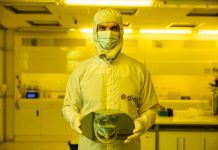Engineers at UNSW Sydney have taken a major step towards solving a long-standing problem about giving qubits – the basic units of quantum information – more breathing space by developing a jellybean-shaped quantum dot.
Jellybean quantum dots are elongated areas between qubit pairs that create more space for wiring without interrupting the way the paired qubits interact with each other, the university said in a press release.
In the study, published in Advanced Materials, the UNSW team of engineers describe how they showed in the lab that jellybean quantum dots were possible in silicon.
According to the research group, the findings now open the way for qubits to be spaced apart to ensure that the wires necessary to connect and control the qubits can be fit in between.
Lead author Associate Professor Arne Laucht explained the jellybean quantum dot is not a novel concept in quantum computing, and it has been explored as a solution to some of the numerous paths toward developing the world’s first operational quantum computer.
“It has been shown in different material systems such as gallium arsenide. But it has not been shown in silicon before,” he said.
Given that silicon chips are already used in conventional computers, silicon is perhaps one of the most crucial materials in quantum computing, according to Laucht.
He said that the infrastructure to build future quantum computing chips is already accessible, and another advantage is that we can pack a large number of qubits (in the form of electrons) on a single device.
“But because the qubits need to be so close together to share information with one another, placing wires between each pair was always going to be a challenge,” the associate professor noted.
To create the jellybean, the engineers created a chain of electrons by trapping extra electrons in between the qubits.
This serves as the quantum equivalent of a string phone, allowing the two paired qubit electrons at each end of the jellybean to continue communicating with one another.
Only the electrons at each end are involved in computations, whereas the electrons in the jellybean dot serve to maintain their interaction while they are separated.
The lead author of the paper, former PhD student Zeheng Wang, said the number of extra electrons pulled into the jellybean quantum dot is critical to how they arrange themselves.
“We showed in the paper that if you only load a few electrons in that puddle of electrons that you have underneath, they break into smaller puddles. So it’s not one continuous jellybean quantum dot, it’s a smaller one here, and a bigger one in the middle and a smaller one there. We’re talking of a total of three to maybe ten electrons,” Wang explained.
Wang added that the jellybean only becomes more continuous and uniform when the number of electrons is increased to 15 or 20.
Moving forward, Associate Professor Arne Laucht said the next step is to insert working qubits at each end of the jellybean quantum dot and make them talk to one another.
“It is great to see this work realised. It boosts our confidence that jellybean couplers can be utilised in silicon quantum computers, and we are excited to try implementing them with qubits next,” Laucht noted.




















